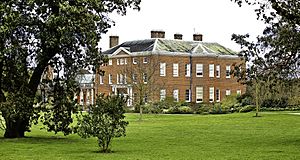Hatchlands Park facts for kids
Quick facts for kids Hatchlands Park |
|
|---|---|

East front of the house
|
|
| Type | Country house |
| Location | East Clandon, Surrey |
| OS grid reference | TQ 06733 52009 |
| Built | 1750 |
| Architect | Stiff Leadbetter |
| Owner | National Trust |
|
Listed Building – Grade I
|
|
| Official name: Hatchlands | |
| Designated | 14 Jun 1967 |
| Reference no. | 1294970 |
| Official name: Hatchlands | |
| Designated | 27 July 2007 |
| Reference no. | 1001697 |
| Lua error in Module:Location_map at line 420: attempt to index field 'wikibase' (a nil value). | |
Hatchlands Park is a beautiful red-brick country house with large gardens in East Clandon, Surrey, England. It covers about 170 hectares (430 acres) and is located near Guildford. Hatchlands Park has been a very important historical building since 1967. Its gardens were also recognized as important in 2007.
Contents
History of Hatchlands Park
Early Beginnings
Hatchlands Park was first owned by Chertsey Abbey, a religious community. The park was even mentioned in the Domesday Book, a famous survey from 1086.
In 1544, after Henry VIII closed down many monasteries, he gave the park to Sir Anthony Browne and his wife, Lady Elizabeth Fitzgerald. The first drawing of the park was made in 1693 by John Seller.
New Owners and Changes
In 1750, Admiral Edward Boscawen bought the park. He hired the architect Stiff Leadbetter to design the house. Admiral Boscawen also planned the gardens.
After Edward Boscawen passed away, his wife Fanny sold the estate in 1770. It was bought by the Sumner family, who worked for the East India Company, a powerful trading company. Both William Brightwell Sumner and his son, George Holme Sumner, made more changes to the property. George Holme Sumner even asked Humphry Repton, a famous landscape designer, to redesign the park and garden. Later, Joseph Bonomi changed some rooms and added a special entrance design to the west side of the house.
Lord Rendel's Era
In 1888, the Sumner family sold Hatchlands Park to Stuart Rendel, who later became Lord Rendel. He made many big changes to the house. Lord Rendel often designed things himself. He also hired his nephew, Halsey Ricardo, and asked Reginald Blomfield to build the Music Room.
Lord Rendel added color and gold to the ceilings designed by Robert Adam. He also decorated the staircase with fancy, curvy designs. He even moved the main entrance of the house to the east side. Lord Rendel also asked Gertrude Jekyll, a famous garden designer, to create the gardens. These gardens include a parterre, which is a formal garden with paths and flowerbeds.
Lord Rendel's grandson, Harry Stuart Goodhart-Rendel, inherited the house in 1913. He was an architect and a British Army officer. In 1945, he gave the estate to the National Trust, an organization that protects historic places.
Today, the house is open to visitors, but it is closed on certain days. However, the parkland is open almost every day of the year. There is also a café and a shop for visitors. The courtyard has a special cobbled surface.
The Interior of the House
The inside of Hatchlands Park is truly amazing. It has beautiful designs by Robert Adam. These designs have a special nautical (sea-themed) style. You can see anchors, cannons, dolphins, and sea-nymphs. Even Neptune, the god of the sea, is featured. These decorations remind everyone of the house's first owner, Edward Boscawen, who was an admiral.
The Cobbe Collection

Hatchlands Park is home to the Cobbe Collection. This collection has 42 historic keyboard instruments, making it the largest group of its kind in the world! Many of these instruments were owned or played by famous composers.
The collection includes harpsichords and fortepianos (an early type of piano) from 1750 to 1840. One special instrument is an Erard pianoforte, which is believed to have been made for Marie Antoinette, a queen of France. This instrument is one of the few French instruments from that time that was not destroyed during the 1789 revolution.
The instruments in the collection were chosen because they were made by highly respected instrument makers or were supported by composers. Twelve of the instruments were actually owned or played by great composers. These include Purcell, J. C. Bach, Mozart, Beethoven, Chopin, Liszt, Mahler, and Elgar.
Hatchlands also displays some paintings from the Cobbe collection. One of these paintings is believed to be one of only two surviving portraits of William Shakespeare painted while he was alive.

